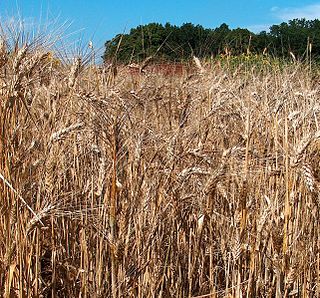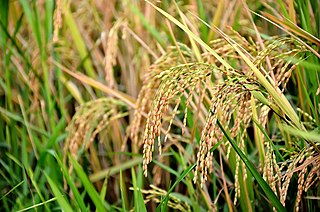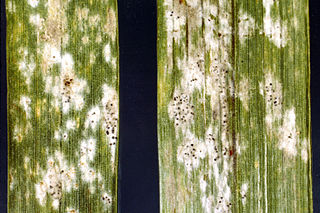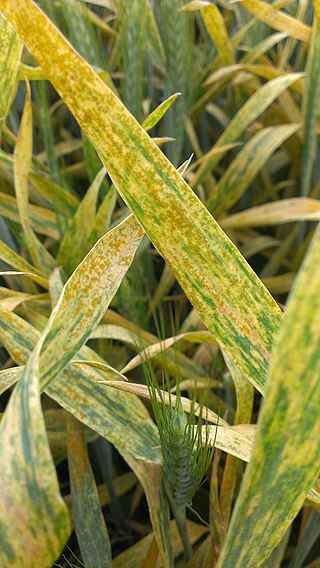
Wheat is a grass widely cultivated for its seed, a cereal grain that is a worldwide staple food. The many species of wheat together make up the genus Triticum ; the most widely grown is common wheat. The archaeological record suggests that wheat was first cultivated in the regions of the Fertile Crescent around 9600 BC. Botanically, the wheat kernel is a caryopsis, a type of fruit.

Rye is a grass grown extensively as a grain, a cover crop and a forage crop. It is a member of the wheat tribe (Triticeae) and is closely related to both wheat and barley. Rye grain is used for flour, bread, beer, crispbread, some whiskeys, some vodkas, and animal fodder. It can also be eaten whole, either as boiled rye berries or by being rolled, similar to rolled oats.

Triticale is a hybrid of wheat (Triticum) and rye (Secale) first bred in laboratories during the late 19th century in Scotland and Germany. Commercially available triticale is almost always a second-generation hybrid, i.e., a cross between two kinds of primary (first-cross) triticales. As a rule, triticale combines the yield potential and grain quality of wheat with the disease and environmental tolerance of rye. Only recently has it been developed into a commercially viable crop. Depending on the cultivar, triticale can more or less resemble either of its parents. It is grown mostly for forage or fodder, although some triticale-based foods can be purchased at health food stores and can be found in some breakfast cereals.

Durum wheat, also called pasta wheat or macaroni wheat, is a tetraploid species of wheat. It is the second most cultivated species of wheat after common wheat, although it represents only 5% to 8% of global wheat production. It was developed by artificial selection of the domesticated emmer wheat strains formerly grown in Central Europe and the Near East around 7000 BC, which developed a naked, free-threshing form. Like emmer, durum wheat is awned. It is the predominant wheat that grows in the Middle East.

Powdery mildew is a fungal disease that affects a wide range of plants. Powdery mildew diseases are caused by many different species of ascomycete fungi in the order Erysiphales. Powdery mildew is one of the easier plant diseases to identify, as its symptoms are quite distinctive. Infected plants display white powdery spots on the leaves and stems. The lower leaves are the most affected, but the mildew can appear on any above-ground part of the plant. As the disease progresses, the spots get larger and denser as large numbers of asexual spores are formed, and the mildew may spread up and down the length of the plant.

Oryza sativa, also known as rice, is the plant species most commonly referred to in English as rice. It is the type of farmed rice whose cultivars are most common globally, and was first domesticated in the Yangtze River basin in China 13,500 to 8,200 years ago.

Common wheat, also known as bread wheat, is a cultivated wheat species. About 95% of wheat produced worldwide is common wheat; it is the most widely grown of all crops and the cereal with the highest monetary yield.
Brassicoraphanus is any intergeneric hybrid between the genera Brassica and Raphanus (radish). The name comes from the combination of the genus names. Both diploid hybrids and allopolyploid hybrids are known and share this name.

Blumeria graminis is a fungus that causes powdery mildew on grasses, including cereals. It is the only species in the genus Blumeria. It has also been called Erysiphe graminis and Oidium monilioides or Oidium tritici.

Triticeae is a botanical tribe within the subfamily Pooideae of grasses that includes genera with many domesticated species. Major crop genera found in this tribe include wheat, barley, and rye; crops in other genera include some for human consumption, and others used for animal feed or rangeland protection. Among the world's cultivated species, this tribe has some of the most complex genetic histories. An example is bread wheat, which contains the genomes of three species with only one being a wheat Triticum species. Seed storage proteins in the Triticeae are implicated in various food allergies and intolerances.
A doubled haploid (DH) is a genotype formed when haploid cells undergo chromosome doubling. Artificial production of doubled haploids is important in plant breeding.

Wheat yellow rust, also known as wheat stripe rust, is one of the three major wheat rust diseases, along with stem rust of wheat and leaf rust.
In statistical genetics, inclusive composite interval mapping (ICIM) has been proposed as an approach to QTL mapping for populations derived from bi-parental crosses. QTL mapping is based on genetic linkage map and phenotypic data to attempt to locate individual genetic factors on chromosomes and to estimate their genetic effects.

Dasypyrum villosum is a species of annual grass in the family Poaceae. It is native to eastern and southern Europe and Western Asia from the Balearic Islands to Turkmenistan, including in the Mediterranean and the Caucasus regions.

Leymus racemosus is a species of perennial wild rye known by the common name mammoth wild rye. It is native to southeastern and eastern Europe, Middle Asia, Caucasus, Siberia, China, Mongolia, New Zealand, and parts of North America. Culms are 50–100 cm long, and 10–12 mm in diameter.
A sequence related amplified polymorphism (SRAP) is a molecular technique, developed by G. Li and C. F. Quiros in 2001, for detecting genetic variation in the open reading frames (ORFs) of genomes of plants and related organisms.
Classical genetics is the branch of genetics based solely on visible results of reproductive acts. It is the oldest discipline in the field of genetics, going back to the experiments on Mendelian inheritance by Gregor Mendel who made it possible to identify the basic mechanisms of heredity. Subsequently, these mechanisms have been studied and explained at the molecular level.

The biosynthesis of benzoxazinone, a cyclic hydroxamate and a natural insecticide, has been well-characterized in maize and related grass species. In maize, genes in the pathway are named using the symbol bx. Maize Bx-genes are tightly linked, a feature that has been considered uncommon for plant genes of a biosynthetic pathways. Especially notable are genes encoding the different enzymatic functions BX1, BX2 and BX8 and which are found within about 50 kilobases. Results from wheat and rye indicate that the cluster is an ancient feature. In wheat the cluster is split into two parts. The wheat genes Bx1 and Bx2 are located in close proximity on chromosome 4 and wheat Bx3, Bx4 and Bx5 map to the short arm of chromosome 5; an additional Bx3 copy was detected on the long arm of chromosome 5B. Recently, additional biosynthetic clusters have been detected in other plants for other biosynthetic pathways and this organization might be common in plants.

Sitodiplosis mosellana, the wheat midge or orange wheat blossom midge, is a species of fly in the family Cecidomyiidae. It is found in the Holarctic, where it is a significant pest of wheat, triticale and rye.
Ernest Robert Sears was an American geneticist, botanist, pioneer of plant genetics, and leading expert on wheat cytogenetics. Sears and Sir Ralph Riley (1924–1999) are perhaps the two most important founders of chromosome engineering in plant breeding.















